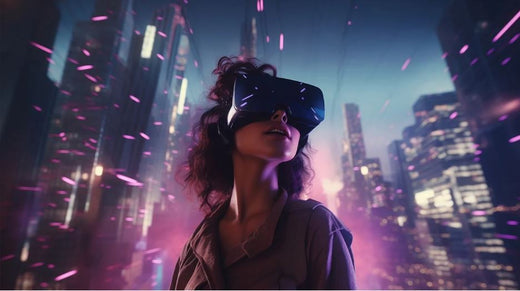
How VR Gaming Technology is Changing Sports
Share
Virtual Reality (VR) has taken the world of sports, and it’s easy to see why. From fan experiences to athlete training, VR is opening doors to new, exciting ways to experience sports. In fact, the global VR sports market, which was valued at $2.3 billion in 2020, is expected to soar to $56.7 billion by 2031.
Here’s a breakdown of how VR is transforming the game for everyone:
1 - Bringing Fans Right into the Action
For sports fans who can’t make it to the stadium, VR is a complete game-changer. Imagine watching a game as if you’re sitting courtside or in the front row—without ever leaving your couch.
VR got its first big debut in sports with the 2016 Summer Olympics in Rio, where fans worldwide could experience the games as if they were there. Since then, leagues across the globe have been exploring VR to bring fans closer, giving them a stadium feel from their living rooms.
2 - Boosting Athlete Performance with VR Training
Athletes are always looking for ways to improve, and VR is stepping up in a big way. Picture a quarterback practicing a play over and over or a cyclist testing out pacing strategies—all in a virtual world.
Programs such as STRIVR have been developing VR videos with the athlete’s point of view in practice, to develop their technique.
3 - Smart Stadiums and Next-Level Fan Experiences
Picture entering a “smart stadium”, where technology replaces humans right from when you get there. Facial recognition at the gate, self-park systems, and VR presentations in the seats makes it more exciting.
With VR headsets, fans in the stadium could get live stats or instant replays as the action unfolds. This technology could bring a whole new level of excitement to live games.
4 - Innovating Sports Equipment Design with VR
VR is also helping to redesign sports equipment in some impressive ways. Designers and engineers use VR to test gear—like shoes, helmets, and even uniforms—in virtual environments before anything is made. This lets them perfect everything from comfort and performance to durability.
Take running shoes, for example. Instead of creating physical prototypes, designers can run virtual tests to see how the shoes would hold up in different conditions. This not only speeds up the design process but also helps athletes get the most advanced, well-fitted equipment possible.
5 - Making Exercise Fun with VR Gamification
One of the coolest parts of VR in sports is the way it makes working out feel like a game. By combining physical activity with gameplay, VR headsets turn exercise into something fun and engaging.
VR apps and games allow users to train skills or just have a great time playing sports in a virtual world. This is a huge win for anyone who finds traditional workouts boring. With VR, even something as simple as running or hitting a tennis ball can be turned into a game.
6 - Bringing Sports and Gaming Together for Partnerships
By connecting fans and brands in a digital space, VR brings tons of opportunities for new partnerships in sports.
This could change the way we see sponsorships and advertising too. Imagine brands that are no longer just on jerseys or stadium ads, but instead are embedded in VR experiences themselves. VR makes it possible to create highly customized interactions between fans, sponsors, and teams—taking fan engagement to a whole new level.
Key Takeaway
VR gaming technology is bringing sports into a whole new era, from changing how athletes train to transform how fans experience games. And as VR gaming headsets and technology continue to evolve, we’re only going to see more incredible advancements. VR isn’t just a fun gadget—it’s in fact, shaping the future of sports.
